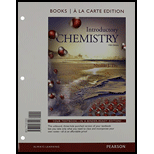
Concept explainers
Interpretation:
The metal which forms one type of ion or more than one type of ion in all the compounds is to be determined and each ionic compound is to be named accordingly.
Concept introduction:
Compounds composed of one or more cations paired with one or more anions are termed as ionic compounds.
Cations are metals and anions are non-metals.
Ionic compound is composed of a metal and a non-metal.
If the metal is transition metal, it can form more than one type of ion.
For
To name the ionic compounds that contain the metals form one type of ion, first, write the name of cation, followed by the base name of the anion with suffix –ide.
In order to name the ionic compounds that contain metals which can form more than one type of ion, first, write the name of cation followed by the charge of the cation in roman numeral in parenthesis followed by the base name of the anion with suffix -ide.
Want to see the full answer?
Check out a sample textbook solution
Chapter 5 Solutions
Introductory Chemistry, Books a la Carte Edition & Modified MasteringChemistry with Pearson eText -- ValuePack Access Card -- for Introductory Chemistry Package
- The empirical formula of a covalent compound is CH2. Which of the following is not a possible chemical formula for this compound?arrow_forwardA molecular compound has the formula, C6H10. Enter the name of the compound.arrow_forwardGiven the following elements: Si, Sr, Cu, Ti, S (a) which of those elements would have the larget atomic radius? (b) which of those elements would have the highest ionization energy? (c) which of those elements would have the lowest electronegativity?arrow_forward
- The compound Ag2S is responsible for much of the tarnish found on silverware. Name this compound, and give the charge on the silver ion.arrow_forwardIn the compound Pt(C2H3O2)2, what is the charge on the platinum?arrow_forwardWhat is the chemical formula of the following compound? What would be possible identities of the anion and cation?arrow_forward
- Isopropanol is a liquid at room temperature. It is dangerous to heat volatile liquids over a Bunsen burner, so you skip that step. Based on these observations, is isopropanol an ionic or molecular compound?arrow_forwardWhat is the name of this covalent compound - P2O7arrow_forwardWhat bonds does NH4Cl consist of?arrow_forward
 Chemistry for Engineering StudentsChemistryISBN:9781337398909Author:Lawrence S. Brown, Tom HolmePublisher:Cengage Learning
Chemistry for Engineering StudentsChemistryISBN:9781337398909Author:Lawrence S. Brown, Tom HolmePublisher:Cengage Learning Introduction to General, Organic and BiochemistryChemistryISBN:9781285869759Author:Frederick A. Bettelheim, William H. Brown, Mary K. Campbell, Shawn O. Farrell, Omar TorresPublisher:Cengage Learning
Introduction to General, Organic and BiochemistryChemistryISBN:9781285869759Author:Frederick A. Bettelheim, William H. Brown, Mary K. Campbell, Shawn O. Farrell, Omar TorresPublisher:Cengage Learning

